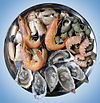- Venison
-
Venison is the meat of a game animal, especially a deer[1] but also other animals such as antelope, wild boar, etc.
Contents
Etymology
The word derives from the Latin vēnor (to hunt or pursue). This term entered English through Norman in the 11th century, following the Norman invasion of England, and the establishment of Royal Forests.
Definition
Venison originally described meat of any game animal killed by hunting,[2] and was applied to any animal from the families Cervidae (deer), Leporidae (hares), and Suidae (wild pigs), and certain species of the genus Capra (goats and ibex), such as elk, red deer, fallow deer, roe deer, moose, reindeer/caribou, pronghorn, brown hare, arctic hare, blue hare, wild boar, and ibex, but its usage is now almost entirely restricted to the flesh of various species of deer.[citation needed] In Southern Africa, venison is the meat of antelope.[citation needed] There are no native Cervidae in sub-Saharan Africa.
Food
Venison may be eaten as steaks, tournedos, roasts, sausages, jerky and minced meat. It has a flavor reminiscent of beef, but is richer and can have a gamey note.[3] Venison tends to have a finer texture and is leaner than comparable cuts of beef.[4] However, like beef, leaner cuts can be tougher as well. Venison cooked beyond medium rare will take on a heavy gamey flavor.[citation needed]
Organ meats of deer are eaten, but would not be called venison. Rather, they are called noumbles[5].
Venison lean is higher in moisture, similar in protein and lower in calories, cholesterol and fat than most cuts of grain-fed beef, pork, or lamb.[6]
Venison has enjoyed a rise in popularity in recent years, owing to the meat's lower fat content. It can often be obtained at less cost than beef by hunting (in some areas a doe license can cost as little as a few dollars), many families use it as a one to one substitute for beef, especially in the US mid-south, Midwest, Mississippi Valley and Appalachia. In many areas, this increased demand has led to a rise in the number of deer farms. What was once considered a meat for unsophisticated rural dwellers has become as exotic as ostrich meat to urbanites.[citation needed]
Venison jerky can be purchased in some grocery stores, ordered online, and is served on some airlines.
Venison burgers are typically so lean as to require the addition of fat in the form of bacon, olive oil or cheese, or blending with beef, to achieve parity with hamburger cooking time, texture, and taste. Some deer breeders have expressed an interest in breeding for a fatter animal that displays more marbling in the meat.
Kosher
Venison can be kosher, as deer are ruminants and possess completely split hooves, two of the requirements for land animals, and indeed is available kosher in places such as Israel, New York, and Chicago. However, kosher venison is not available in the UK. In the early 20th century, there would be a once-a-year supply of kosher venison in the UK, when a group of shochets would travel to the Rothschild family's estate and catch and slaughter some deer in the appropriate manner on the estate. This has not, however, been done for many years.
Europe
Venison is widely available in European supermarkets through the traditional hunting season, October to December. The main cuts available to European consumers are derived from the saddle and the hind leg. Diced venison is also readily available in frozen form in most supermarket freezer bins. Most of this venison comes from New Zealand.[citation needed]
North America
In North America, venison is less available at retail due to the requirement that the animal is first inspected by USDA inspectors. There are very few abattoirs which process deer in North America, and most of this venison is destined for restaurants. Most venison sold through retail in the USA will come from New Zealand. It is available through some high end speciality grocers and some chains which focus on more 'natural' meats.
Chronic Wasting Disease
Since it is unknown whether chronic wasting disease, a transmissible spongiform encephalopathy among deer (similar to mad cow disease), can pass from deer to humans through the consumption of venison, there have been some fears of contamination of the food supply.[7] Recently, several known cases of the disease have occurred in deer farms throughout the United States and European farms in Scandinavia may also have had several cases.
Farmers now have had tests developed especially for the particular species they raise to obtain better results than those used on cattle.
References
- ^ "Webster Dictionary". http://www.merriam-webster.com/dictionary/venison.
- ^ http://www.merriam-webster.com/dictionary/venison
- ^ http://www.extension.umn.edu/foodsafety/components/columns/Nov10.htm
- ^ http://www3.interscience.wiley.com/journal/119835351/abstract?CRETRY=1&SRETRY=0
- ^ http://cunnan.sca.org.au/wiki/New_noumbles_of_Deer_(recipe)
- ^ http://www.nal.usda.gov/fnic/foodcomp/search/%7CUSDA Nutrient Database, NDB numbers 17348, 13434, 10023 and 17060
- ^ Chronic Wasting Disease and Potential Transmission to Humans Belay ED, Maddox RA, Williams ES, Miller MW, Gambetti P, Schonberger LB. June 2004. Emerging Infectious Diseases, an internet publication of Centers for Disease Control and Prevention. Last accessed 2009-11-23
External links
Meat Poultry/Game 

Livestock Fish/Seafood Crab • Crayfish • Lobster • Prawn • Shrimp • Anchovy • Basa • Bass • Catfish • Carp • Cod • Crappie • Dolphin • Eel • Flounder • Grouper • Haddock • Halibut • Herring • Kingfish • Mackerel • Mahi Mahi • Marlin • Milkfish • Orange roughy • Perch • Pike • Pollock • Salmon • Sardine • Sole • Swordfish • Tilapia • Trout • Tuna • Walleye • Whale
Cuts / Preparation Other Butchery • Ethics • Preservation • Slaughter • Red meat • White meat
Categories:- Meat
- Vermont cuisine
Wikimedia Foundation. 2010.




